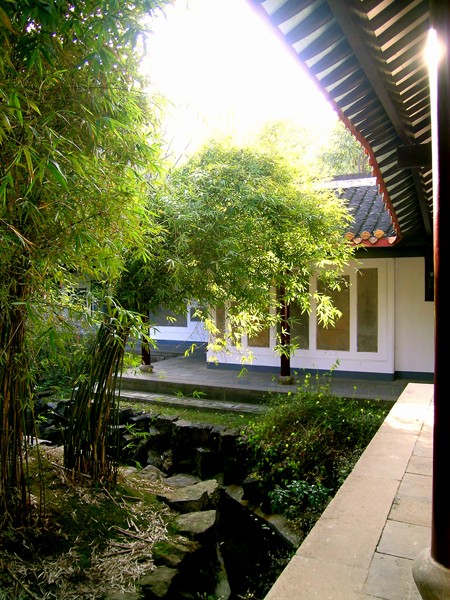From the tenth century onward, academies (shuyuan) were major contributors to Confucian education and the formation of literati culture in imperial China. My current book project, focusing on the Song Dynasty (960–1279), builds on a theory of the gaze in Chinese visual culture. It is part of long-term research on the significance of gardens, landscape, and architecture in Confucian teaching and ritual in China and East Asia.
Major Song academies, often located in secluded mountain areas, housed independent schools of neo-Confucian philosophy. Scholarly debates and lectures were conducted in these compounds, gardens, and landscapes and were commemorated in poems and books by masters and their disciples. Pedagogical engagement with nature was considered instrumental to a scholar’s individual quest for self- cultivation and Confucian enlightenment. All these philosophical activities rested on a visual culture, at great variance with that of post- Renaissance Europe, that pointed to a landscape vision shared throughout Song visual materials, textual records, and physical surroundings. A phenomenology of the Chinese gaze based on study of the classics from antiquity to the Han dynasty (206 BCE–220 CE) reveals that the gaze, which assumed mutuality between the observer and the observed, did not separate affect and percept and could stimulate the communication of ethical principles. The gaze was further honed in the following centuries by the introduction of Buddhist visualization practices and the importance of “seeing” in neo-Confucian epistemology. Visuality provided a powerful tool for the propagation of the Buddhist and Daoist religions and propelled the creation of numinous landscapes as sources of new ethics at a remove from imperial control. In the same way, visuality aided the development of neo-Confucian philosophy, which entailed the establishment of a network of academies often at odds with existing religious territories. Yet, several questions remain: How did vision enact, and act upon, place-making?
My manuscript investigates three academies: Yuelu Academy on the Xiaoxiang tributaries: White Deer Grotto Academy, in a Buddhist mountain domain; and Wuyi Jing She Academy, in a Daoist mountain domain. All three academies attributed their foundation to the leading philosopher Zhu Xi (1130–1200), whose synthesis of neo-Confucian thought dominated Chinese elite life up to the beginning of the twentieth century. In these academies, intellectual inquiries paralleled garden gatherings and landscape tours. The interweaving of their spaces with extant sacred sites and the intertwining of their architecture and the natural environment provided the basis for a broader discussion of the web of exchange between conflicting beliefs that contributed to the formation of a unique visual culture of place, memory, and literati identity in the Song dynasty, a pivotal moment that facilitated transformations in the Chinese landscape arts of ink painting and garden-making.
During my two-month residency, I explored the expression of a famous landscape theme—the Eight Views of Xiaoxiang, which originated in the region around Yuelu Academy—through different media: painting, poetry, woodblock prints, and gardens. Although the Eight Views subject was best celebrated in painting, book illustrations and local landmarks were fundamental to its dissemination and continuation. Its connections with and appropriations by the Yuelu Academy demonstrated the construction of the gaze and place-making on the one hand and the role of nature in the shaping of neo-Confucian identity on the other. The first known set of the Eight Views was painted by Song Di (c. 1015–1080), a friend of neo-Confucian master Zhou Dunyi (1017–1073), and was displayed on a terrace opposite the Yuelu Academy. The Ch’an monk Juefan Huihong (1071–1128) cited the academy when he was challenged to compose poems on the Eight Views in order to outshine the painted vision with a literary one. The Eight Views theme was established thereafter as a popular genre of serial landscape painting and poetry in Song China. Later, the tradition entered Goryeo Korea with neo-Confucianism and Muromachi Japan with Ch’an (Zen) Buddhism. Gradually, it also evolved into forms of literary Ch’an, lyrical verses, zither music, design motifs, and representations of local scenery, garnering a unique position in East Asian visual culture that it holds to this day. It was already a long-established genre when the seventeenth-century compilers of the official history of the academy, Yuelu shuyuan zhi (Gazetteer of Yuelu Academy), included a selected set of woodblock prints of the Eight Views to proclaim the academy’s cultural and regional prominence. Later, in the early eighteenth century, gardens were built at the academy and named Eight Views of the Academy in an unmistakable reference to the classical subject. In addition, the gazetteer was reissued and expanded to incorporate new poems about the gardens. Unraveling the intricate history of the Eight Views calls for a study of the intentionality at play in the Chinese gaze and the sense of place promoted in neo-Confucian epistemology and pedagogy.
